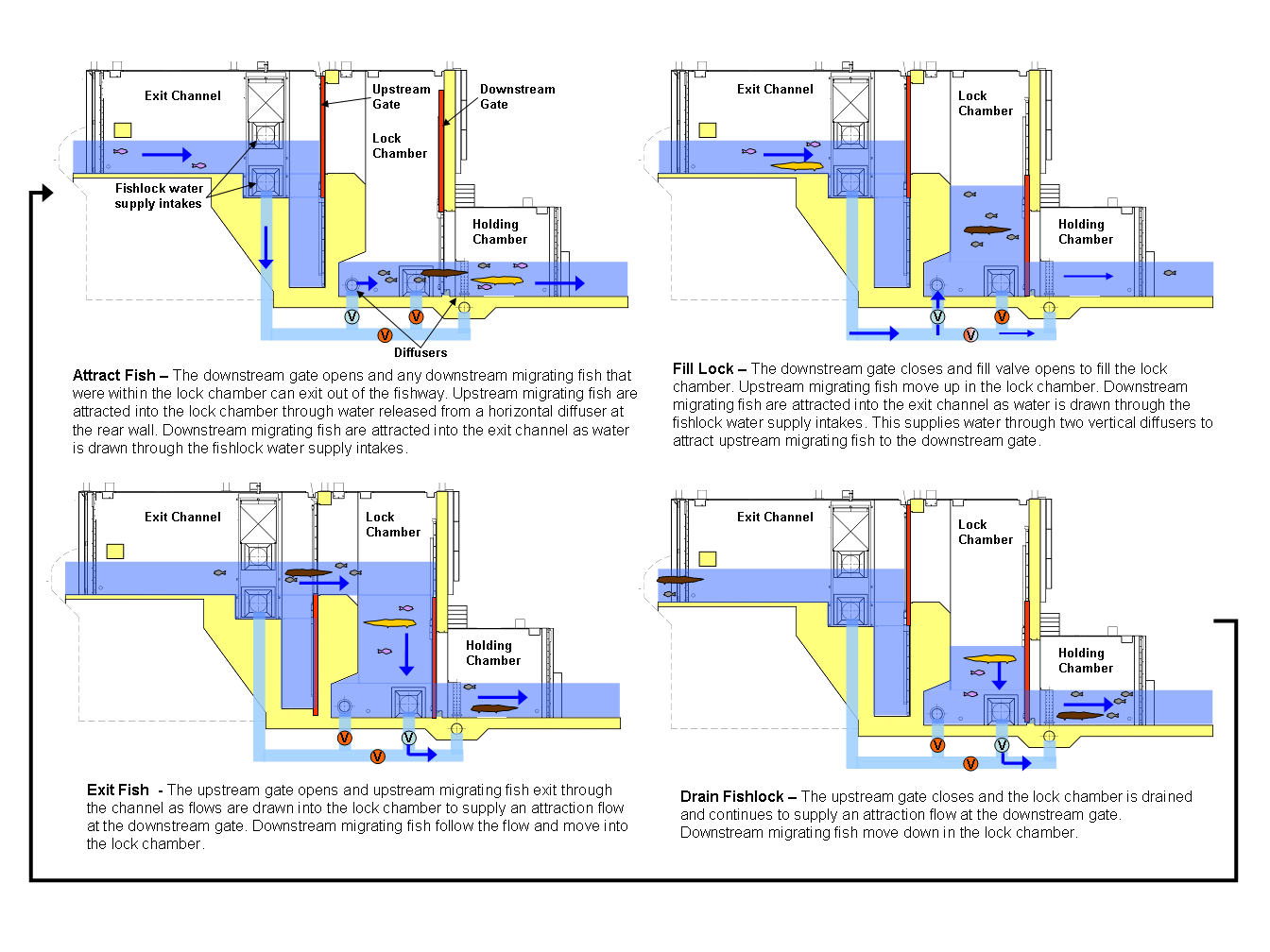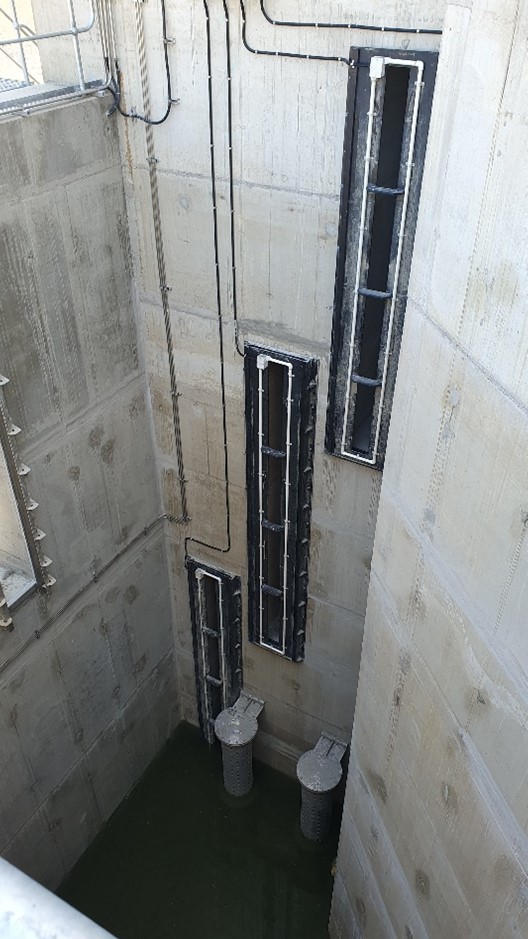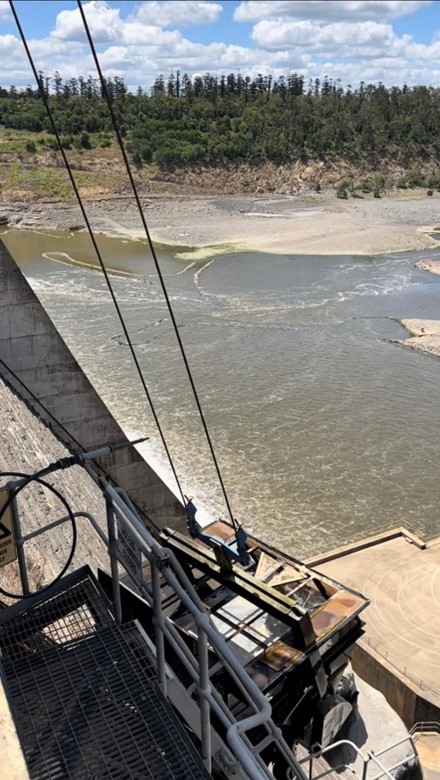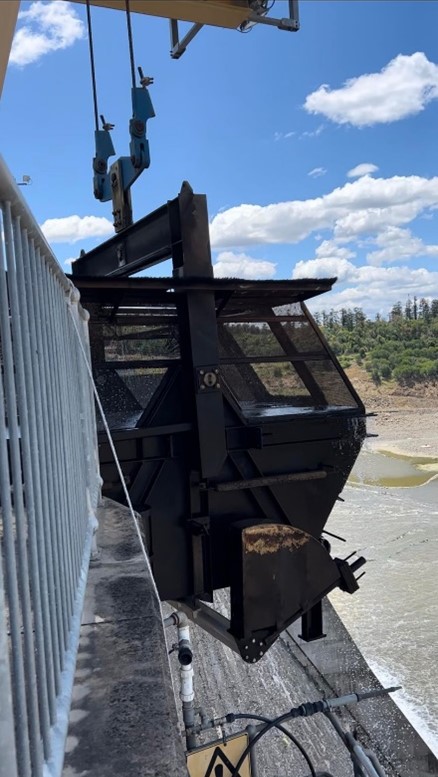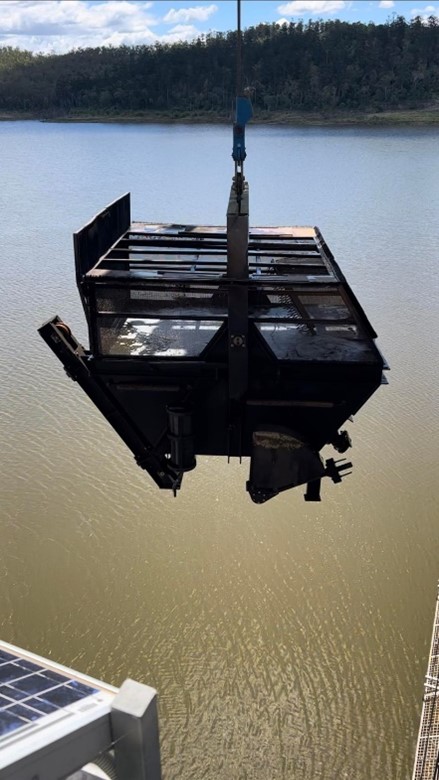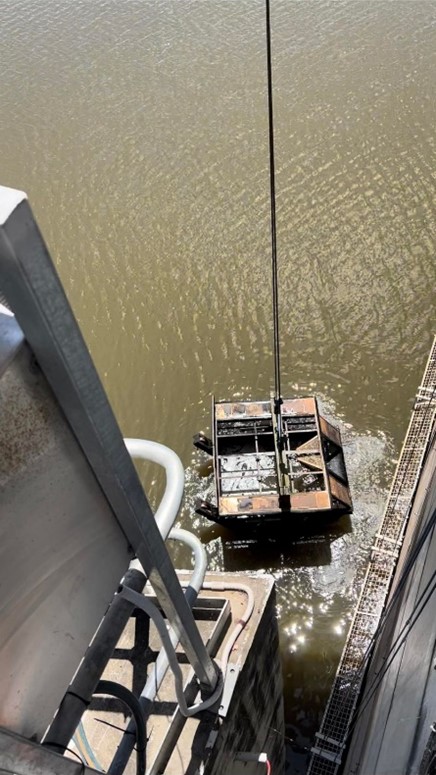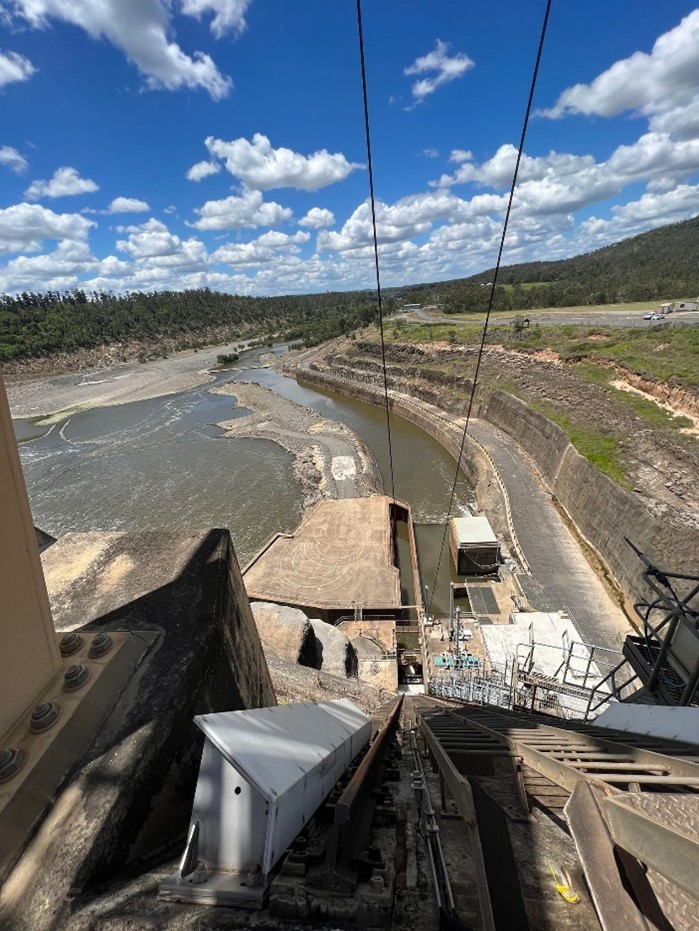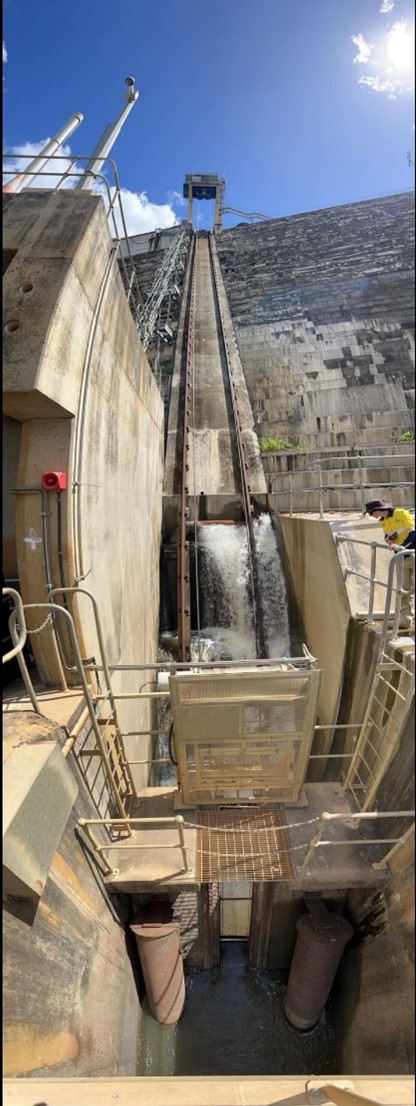|
|
Mechanical fishwaysMechanical fishways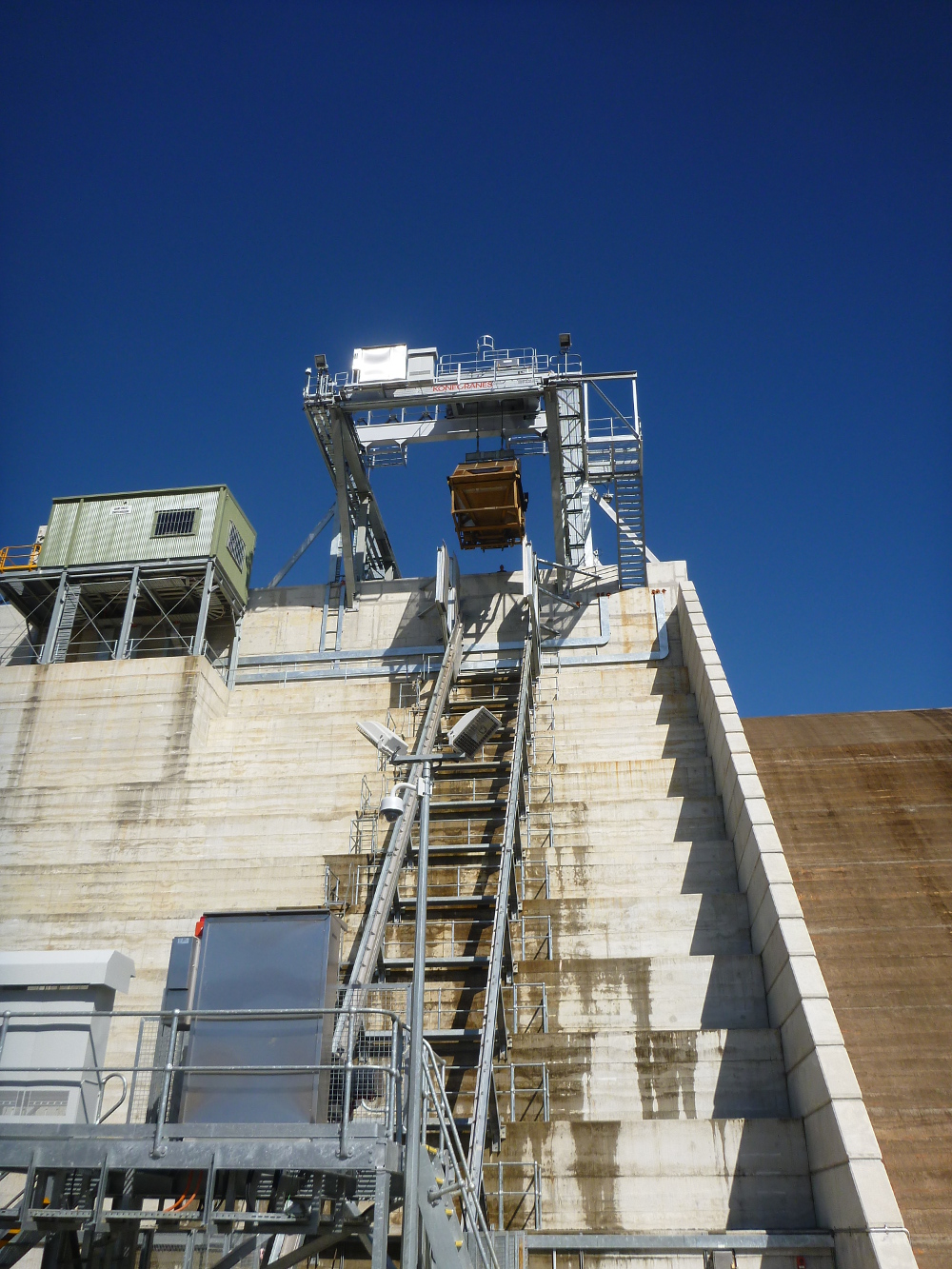 DescriptionMechanical fishways are structures that have moving parts to transfer fish from one side of a barrier to the other. Mechanical fishways are suited to medium to large barriers and pass a broad size range of fish[5]. Fish passage over barriers is vital to sustain healthy fish stocks[2]. Providing fish passage over large barriers namely dams and weirs is complex, because traversing the difference in water levels above and below a barrier (headwater - tailwater) requires intervention[5]. Mechanical fishways are highly technical and usually involve higher costs than non-mechanical fishways[1][6]. Mechanical fishways operate by attracting fish into a sealable chamber (or hopper) at the downstream side of the barrier (tailwater level)[5]. The chamber is moved or filled to the storage level of a dam impoundment or weir pool, where fish can exit the chamber on the upstream side of the barrier. Mechanical fishways are also designed to pass fish safely downstream, usually by operating in reverse for the downstream cycle. This is an important consideration for catadromous species, such as barramundi, bass and striped mullet (valuable commercial and recreational fishes), that migrate downstream to estuarine areas to spawn. Sub-typesThere are two main sub-types of mechanical fishways: fish locks and fish lifts. Fish locks are used to move fish over barriers that are typically 5m high or more. Fish locks generally consist of a large holding chamber located at the downstream level of a barrier, connected to an upstream chamber by either a sloping or vertical shaft[4][6][5]. Fish locks have been built on weirs on the Pioneer, Fitzroy-Dawson, Burnett, Logan and Burdekin river systems in Queensland. Fish lifts are used to move fish over barriers that are typically 10m high or more. A fish lift is a system that first traps the migrating fish in a suitably sized chamber (tank or hopper) of water located at the base of a barrier, which is then raised and emptied upstream[4][6][5]. Fish lifts have been installed at Paradise and Wyaralong Dams in Queensland. Operation and cycle phasesFish lockA fish lock includes gates, the entrance holding chamber, the lock chamber, and gates at the exit channel. Automatic control gates are generally fitted to each end of the upstream and downstream chambers. Fish locks have four basic phases in a cycle: attract, fill, exit, and drain[6].
Fish locks can be designed for effective downstream fish passage by operating in reverse by attracting fish on the upstream side of the barrier into the chamber, and then draining the chamber with the exit phase on the downstream side. Fish liftA fish lift consists of a trapping system that uses water flow to attract upstream migrating fish into a water filled hopper. The hopper and fish are lifted over the barrier via a winch mechanism and cables along a guide track. Fish lifts include the following basic phases in a cycle: attract, lift and empty[1][3][6].
Fish lifts are not generally designed to provide downstream fish passage, a fish lock or downstream bypass channel is more suited to this task.
Key considerationsMechanical fishways must be designed by a suitably qualified and experienced fish passage biologist and civil engineers to ensure that they are reliable and adequately provide fish passage for the entire fish community, taking into consideration the movement requirements and swimming abilities of fish and the hydrological conditions of the site[2]. Likewise, construction should be overseen by a suitably qualified and experienced fish passage biologist to ensure any adjustments or modifications do not impact fish behaviour or the passage function of the fishway. Subsequent monitoring is likely to be required to ensure the fishway provides the fish passage designed and to optimise the fishway and dam or weir operations[2]. Planning and designMechanical fishways must be designed, constructed and maintained to ensure that the hydraulic conditions throughout the fishway are suitable for the swimming abilities and behaviours of the entire fish community moving through the site[2]. The entry and exit locations and conditions are critical as are attraction flows and flow conditions within the fishway such as degree of turbulence and velocities[4]. Monitoring information should feed into fishway and impoundment operational and maintenance management plans which are required to demonstrate they will function together to deliver the effective operation and maintenance of the fishway and to ensure it provides adequate fish passage. An operational plan should include details of all automated processes to facilitate passage for the trapping, movement and release of fish over a barrier. The frequency of fish movement operations should minimise delays to fish passage and optimise the condition of fish and their survival upon release[2]. Ensuring effective ongoing operation requires adequate resources and timeliness of repairs, with consideration of the availability and sourcing of spare parts that may be susceptible to damage[2]. New mechanical fishways should be subject to a detailed commissioning phase to enable the optimum operating regime to be determined under a variety of flow and seasonal conditions, This also requires flexibility and accessibility to be built into the fishway and associated outlet designs that allows accurate adjustments to be made. Relatively minor discrepancies in execution and operation of the fishway can result in sub-optimal fish passage outcomes. Mechanical fishways require ongoing and regular inspections and sufficient personnel and resources to carry out maintenance for the life of the instream structure. A maintenance plan should detail the timing of, and triggers for, event-based inspections (e.g. following flood events, failures or breakdowns, reports from public or other stakeholders, and as required by an’ alert to action’). Contingency measures must be implemented if deficiencies are found with the fishway[2]. A monitoring plan is usually required to document the performance of mechanical fishways. It is essential that mechanical fishways are designed to allow the installation of monitoring equipment that may be required, such as cages, traps or video surveillance equipment at the fishway inlets and outlet[2]. To determine the range and size classes of species that are present at the site, it is important to monitor both the downstream and upstream sides of the fishway to ensure that fish being attracted to the fishway entrance are successfully using the fishway[2]. Requirements for effective fish passageDifferent species and size classes of fish have varying requirements for movement. For example, Australian bass generally tend to move downstream for spawning on suitable flows throughout winter and return upstream during the first number of significant post-winter flows. However, rainbow fish and many other small-bodied species generally move year-round during low flows[2]. Releases through the fishway must be prioritised and sufficient to attract the whole fish community to the fishway entrance and meet behavioural and biological requirements. These flows should enable fish to successfully find and enter a fishway without depleting their energy reserves[2]. The effectiveness of the fishway in providing fish passage is not to be compromised by the operation of the barrier. For example, releases should always be prioritised through the fishway and then augmented from the outlet works to reach the target release volume. The efficiency of mechanical fishways depends mainly on the behaviour of the fish which must remain in the downstream chamber during the entirety of the lock or lift cycle; including the attraction phase, followed by the filling stage, or lifting phase, and when the chamber empties[6][4]. The turbulence and velocity of attraction flows into the downstream chamber must be acceptable for fish[6]. For fish locks, the chamber should not be filled too quickly during the lifting phase; excess turbulence and aeration is likely to result in unfavourable conditions for fish and discourage them from rising with the water level during the filling stage[6]. The exit and drain phases should include sufficient time for fish to leave the lock to prevent fish from being swept back downstream when the lock empties[6] and the location of the fishway exit in relation to the spillway is crucial to prevent exiting fish from being swept over the spillway when the barrier is overtopping. The timing, duration and frequency of each phase is dependent on the fish passage requirements of the fish community and biomass within a system[2]. However, the fishway should be continuously operated whenever there is any inflow into the dam or weir or any releases or spills from the impoundments. Suitability and limitationsLike all mechanical systems, mechanical fishways require regular maintenance to ensure their reliability, efficiency, safety, and performance. This involves ongoing costs for the perpetuity of the barrier and associated fishway[6]. Due to the nature of mechanical fishways trapping and holding fish over various phases, increased predation is possible. Predation is most likely to occur between different size classes of fish within a holding chamber[2]. More frequent cycling of the fishway assists in the reduction of predation. Disclaimer: In addition to the standard disclaimer located at the bottom of the page, please note the Fishways (biopassage structures) disclaimer. References
Last updated: 29 May 2024 This page should be cited as: Department of Environment, Science and Innovation, Queensland (2024) Mechanical fishways, WetlandInfo website, accessed 8 May 2025. Available at: https://wetlandinfo.des.qld.gov.au/wetlands/management/fish-passage/technologies/fishway-options/mechanical/ |

 — Department of the Environment, Tourism, Science and Innovation
— Department of the Environment, Tourism, Science and Innovation

